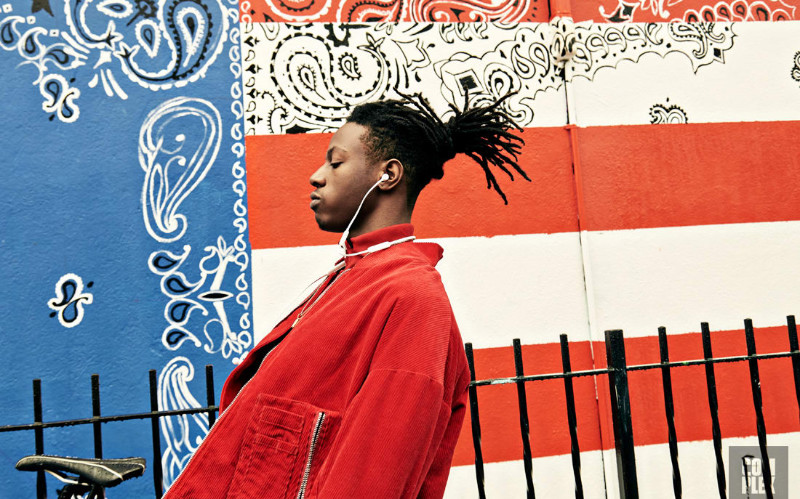The Underground Rhetoric: Laying Tracks for Social Justice
Talia Fishbine
Hip-hop, as a music genre and culture, has often been subjugated to a space outside the purview of mainstream suburban, white America.[1] It has been discounted within many circles as a perpetual culture of misogyny and the glorification of illicit activities[2]; this oversimplification of hip-hop, however, is problematic insomuch that it denies the rhetorical richness of such a mode of expression. Indeed, academics ranging from H. Samy Alim to Gwendolyn D. Pough have contributed crucial analyses to the discursive understanding of the genre as rhetorically and socially meaningful, but, within the context of the aforementioned mainstream, it remains condemned to an underground-of-sorts—a shadowy place hidden from the realm of critical consideration. Rap, in particular, has utilized this subjugated position to establish a tradition of social advocacy. Jo-Vaughn Scott (stage name Joey Bada$$) has arisen from this tradition to contribute to the social justice avenues pursued by rap, delivering these messages of social justice to communities which have been historically marginalized and forced, along with hip-hop, into their own underground. Scott’s fluidity as a figure is such that he simultaneously reaches across to two audiences: he addresses the conventionally “mainstream” audience by challenging stereotypes of rap music and its proponents, while also addressing a marginalized audience by encouraging a critical consciousness of social reality and advocating for action. The urgency in engaging with Scott’s work is foregrounded by problematic power dynamics in the U.S. that have made it ethically necessary to shine light on underground rhetoric that works to draw attention to, as well as correct, societal injustices. Understood, then, through the rhetorical framework provided by Catherine Helen Palczewski, Richard Ice, and John Fritch in Rhetoric in Civic Life, Scott’s music and actions—evidenced in interviews, album covers, and lyrics, respectively—aid in the fight to pull the underground rhetoric above-ground—an endeavor that is correlative with an overarching aim to further the social justice advocacies established within the existing tradition of hip-hop.
HOT 97 Interview: Performativity
Performance is “all the activity of a given participant on a given occasion which serves to influence in any way any of the other participants.” [3]
Video interviews are an interesting brand of rhetorical text because of their unique ability to meld traditional verbal rhetoric with a nonverbal rhetoric of persona (which is typically more grounded in “reality” when presented in an interview than in lyrics or music videos). Earlier this year, Scott appeared on a HOT 97 filmed interview accessible via YouTube entitled “Joey Badass Talks Inspiring A New Generation, Out Of Body Experiences, + Chance’s Grammys” to discuss a myriad of topics, ranging from his (at the time) upcoming album to his perspective of social reality. Performativity is a significant element of this interview, as it establishes a persona that functions on multiple levels to communicate Scott’s identity to audiences. This identity initially comes across as the trope of “stereotypical rapper” because of his informal dress, speech, and demeanor. Palczewski et al. assert, “Although personae are rhetorically constructed, an archetypal form for the persona may preexist the rhetorical action in which it is performed” (166). In this particular case, Scott fulfills the prescribed persona attributed to rappers, largely through his nonverbal presentation of self. However, the verbal component of his interview defies the aforementioned construction of personae when he touches on issues of social importance. In one section of the interview, he mentions the influence Marcus Garvey, a well-respected Civil Rights activist, has had on him: “I was reading the philosophy and opinions of Marcus Garvey and there was this one quote that stood out to me, which was, ‘What you do today that is worthwhile will inspire others to act at some future time.’ And, you know, that was pretty much like the basis of that whole record which inspired me to make that” (Joey Badass Talks). Here, Scott evokes an identity beyond the typecast of “uneducated rapper” as he reveals the knowledge that must necessarily precede this reconstituting of activist ideologies in musical form. Palczewski et al. once again articulate this performance of persona: “People can also perform roles in ways that challenge the society’s values in order to highlight unspoken (and sometimes contradictory) norms attached to particular social roles” (169). Viewed from this perspective, Scott’s initial appearance in the interview establishes his identity as a rapper based on mainstream audience expectations, while his nod toward the intellectual work of an influential historical figure reestablishes him as a rapper whose identity is in conflict with those audience expectations.
This duality of Scott’s persona works to his advantage when he begins to discuss the role that audience members play in the bigger picture of social movements. When discussing a controversial moment in which he had claimed to be better than Tupac Shakur, a late rapper known for the social consciousness of his music, Scott again establishes and reestablishes his identity: he first establishes himself as a rapper whom Tupac greatly influenced, yet he reestablishes himself as a rapper who stands apart from Tupac in the sense that he not only wants others to share that social consciousness, but develop it competitively, too. Passionately, he insists, “Once you have a generation come and do its work, the generation after that has the opportunity to be better, [be]cause you’ve just set the bar. […] We are the future. We are the youth. We are the next generation” (Joey Badass Talks). Again debunking the common myth of rappers as being driven solely by a need to proclaim their dominance of the “rap game,” Scott simultaneously assumes advancement past Tupac’s contributions—and, by extension, a long line of predecessors who have used their genre as a social platform—while also assuming humility in the face of future generations that he hopes will surpass his own level of social consciousness. In his essay “Message from the Grassroots: Hip Hop Activism, Millennials, and the Race for the White House,” Jeffrey O.G. Ogbar addresses the significance of Scott’s ideas: “For many activists, hip hop had become a crucial vehicle for the political mobilization of young people in ways not seen using any other popular form of music” (42). The intensity with which Scott calls upon youth to mobilize under a realization of their value to society’s future substantiates the critical role that this genre of music—or, in this case, its proponents—plays in the social justice realm.
It cannot go unnoted that Scott’s ability to have a public persona at all is largely due to past rendezvous into the public forum. Although Scott is presented as a person with a certain amount of social power[4] in the context of this interview, what this conceals is the work that went into establishing that social power, which is in no way assured: “The social power a rhetor brings to a situation is relevant only insofar as the audience perceives it. People do not have or lack power in an absolute sense; rather, they have more or less power in relation to others” (Palczewski et al. 176). It is for this reason that Scott situates himself in a comparative relationship with Tupac, as his ability to be recognized by an audience—particularly one intimately familiar with Tupac’s work—as a legitimate cultural figure further drives the legitimacy of his rhetoric. Thus, Scott is able to most thoroughly perform his persona of advocate for a generation of youth by utilizing the social power that he has gained through prolonged performativity. In this sense, performance spawns a more authoritative performance.
ALL-AMERIKKKAN BADA$$ [5]: Rhetoric of Display
Rhetoric of display is “rhetoric that makes ideas present through visual display.” [6]
The time-old adage “a picture is worth a thousand words” finds resonance with the album cover of Scott’s latest release, All-Amerikkkan Badass. Although not the first rapper to envision the word America written with three Ks,[7] the strikeout of these letters makes a uniquely strong visual statement against white supremacy. The fact that the second half of his stage name is written next to “Amerikkkan” insinuates that he is accepting responsibility for an attempt to eliminate racism in America. To add to the potency of this statement, Scott uses himself as an element of visual rhetoric: “Body rhetoric is rhetoric that foregrounds the body as part of the symbolic act” (Palczewski et al. 77). Scott is pictured hanging out of the window of a beat-up vehicle with both middle fingers raised, which is evident despite censoring. Moreover, he is donning a black jacket with the image of a white rope culminating in a noose sprawled across the front. These components of the album cover all function to support the anti-racist stance that is initially depicted by the typography: “An image is a verbal and visual representation, emphasizing particular qualities and characteristics, that creates a perception of the rhetor in the audience’s minds” (Palczewski et al. 180). Scott’s qualities and characteristics, in this particular text, produce an image of militarism.[8] It is this “militarism” that best serves the overarching aim of the visual, as Scott is essentially recognizing—and wearing—the threat of white supremacy while also sending the message, I am here. I am Black. I reject and overcome your attempts to discard me. Just as much as the typography of the album title, Scott’s physicality is the signification of his message.
Although placed behind Scott’s body, the flag depicted on the album cover bears a significant allegorical weight, as well. At first glance, it appears to be an ordinary American flag, but a closer glance yields a divergent reading; indeed, the flag is entirely stitched together of red and blue bandanas. This is highly symbolic on many levels, least of which is a nod to gang culture in America. Gang members have been known to wear and display bandanas with colors that make their gang affiliations readily identifiable to others. Red and blue, respectively, are the colors used to represent the Bloods and the Crips, two notorious gangs with territories ranging as far as Los Angeles to New York (Scott’s birthplace). The rivalry between these two gangs is almost, if not entirely, as infamous as the reputations of the gangs themselves, which is precisely what makes a flag composed of oppositional tribes so rhetorically meaningful. This meaning is twofold: firstly, it states that gang members—a group, in the case of these particular gangs, compiled largely of African Americans[9]—are American, despite the ostracism they have faced at the hands of traditional white America; secondly, it states that African Americans—and all marginalized people, by extension—must be unified, rather than splintered, if they are to fight for social justice. Palczewski et al. touch on the way in which this meaning is understood: “The meaning of a text is not determined by its author, nor is the meaning solely contained in the text. Instead, audiences interpret meanings of visual texts in the process of looking. As a result, a single text or image may have multiple meanings, meanings influenced by the audience’s culture and personal interpretations” (74). To be sure, some prior knowledge regarding gang culture is required for an audience to be able to not only recognize the significance of the visual display of rhetoric, but interpret that display and understand it within a larger cultural context, as well. Ultimately, the fact that this message is most accessible for those most likely to benefit from the specific call for unification validates Scott’s understanding of rhetorical audience.
“LAND OF THE FREE” [10]: Postmodern Perspective
Postmodernism is “the theory that places into question singular explanations, metanarratives, categories, and the certainty of supposedly objective interpretations of the world.” [11]
Although this could be said of many countries, it is particularly true of America that it takes pride in stories that are meant to represent and encompass an entire set of national values. However, these stories often ignore problematic elements of history in the name of patriotism; what this has done, then, is make marginalized communities invisible in the bigger picture of white America. One song in particular on the All-Amerikkkan Badass album entitled “LAND OF THE FREE” attempts to flip the traditional American narratives that have functioned to bolster patriotism at the expense of the Black community, in particular. In the chorus, Scott chants, “In the land of the free, it’s full of freeloaders / Leave us dead in the street to be their organ donors” (Joey Badass). The traditional narrative in America often paints African Americans and other minorities as “freeloaders” because of their use of welfare and other social programs—a narrative which obstinately neglects to acknowledge recipients of welfare and social programs to whom a minority status is not applicable. Scott suggests that this widely disseminated narrative is wrong: white Americans are the “freeloaders” because they benefit from the deaths, and the subsequent absence this represents, of African Americans. This kind of narrative challenge is also locatable in the second verse when he raps, “It’s not enough pots to piss in, too many murder convictions / Another family evicted, another Black man a victim / That’s as real as it’s getting, you should take recognition” (Joey Badass). Again, Scott is taking issue with a misperception, often among white Americans, of the Black man as a criminal—someone whose presence is enough to make people clutch their bags a little tighter and move to the other side of the street. He flips this narrative by saying that the Black man is a victim of the vicious cycles of poverty and violence that America has tried to isolate within his community.[12] In his essay “Postmodern Theory and Hip-Hop Cultural Discourse,” Hunter H. Fine delineates the importance of Scott’s attempt to supersede common social narratives: “Communication is so important to postmodern theory, because it exposes the processes of how we talk about, represent, and construct our reality” (108). Scott’s decision to reconstruct the narrative of “freeloaders” and “victims” in America is an astute rhetorical move, as it reflects his consciousness of reality as a social construction and his ability to use that consciousness in an attempt to reconstruct reality. In this sense, Scott uses a postmodern framework to reach out to his marginalized audiences and offer lyrics that reflect their realities, rather than the realities that traditional narratives intend to shape.
The “LAND OF THE FREE” video merits an analysis because it does not merely evoke images that support the written lyrics,[13] but instead uses the wordless spaces to provide images that continue to affirm Scott’s rhetorical message and carry it further. Approximately one minute before the end of the video, Scott is shown in front of a burning cross. The video immediately cuts to a separate image of him hanging, a noose wound around his neck. Following this, the video cuts back to the burning cross, which is surrounded by people dressed in KKK attire, immediately revealed to be police officers as they remove their white caps. All the while, rain is falling on the men and the cross. This sequencing once again flips a common narrative in America that the police are people in whom one can place his or her trust explicitly. Instead, Scott suggests that the police are just as prone to racism as anyone else; their badges and uniforms are merely a veil behind which dangerous ideologies and bigotry can hide. Scott also challenges the religious undertones of the KKK by contesting the traditional narrative of Christ (in relation to the group) by assuming a Christ-like position.[14] The visual juxtaposition of Scott against the cross and then hanging by a rope indicates that he, similar to Christ, is sacrificing himself for the salvation of his people. Indeed, this is further emphasized by the fact that the rain is a cleansing force; he is willing to sacrifice himself if it reveals the hidden racism in society and dims the burning cross, which suggests that enough cleansing could potentially ameliorate the negative effects of bigotry. At this point in the text, the message shifts from being directed at a sympathetic audience to an antipathetic audience; now, Scott is challenging the narrative within the specific KKK community that Christ serves as the salvation for white people. Palczewski et al. comment, “One insight of contemporary rhetorical and communication theory is that meaning does not really reside in the intent of the author (if one can be identified) or in the text, but in the interaction between an audience and a text” (186). Given this insight, Scott’s message assumes different rhetorical meanings depending on the audience: a Black audience might find inspiration—or, at the very least, comfort—in the newly established narrative that makes Black persons the protagonists, while a nonminority or racially biased audience might feel isolated or threatened by the same newly established narrative. Ultimately, then, Scott’s rhetoric in “LAND OF THE FREE” is meant to dispute that which is commonly and uncritically believed in mainstream America, replacing it instead with a narrative that is reflective of the community excluded from the traditional—and problematic—narratives so routinely circulated in American society.
Conclusion
By design, Scott has ensured that his social justice messages are accessible via myriad forms: spoken, visual, and written. Each is rich in meaning[15] because of the performativity, rhetoric of display, and postmodern perspective imbued in his rhetorical methods. In contrast with rap that is often glorified on many radio stations[16], Scott consciously makes his messages political in the ultimate goal of inducing a younger generation to rise up and take control of their futures. Although largely underground in comparison with other current socially aware rappers (i.e., J. Cole and Kendrick Lamar), this overwhelmingly functions to legitimize his advocacy for communities that are underrepresented and, in this sense, underground, as well. Scott is in the trenches with them, leading the way to social justice through his work as a rapper. While rap is not a traditionally recognized outlet for social advancement within the dominant mainstream culture, this underscores the need for the future work of rhetorical studies to remove hegemonic barriers that incorrectly label hip-hop as incompatible with, and disparate from, meaningful rhetorical work. After all, if the Underground Railroad could play a significant role in leading slaves to freedom, perhaps the Underground Rhetoric can play a significant role in leading their descendants[17] to a socially just America.
Footnotes
[1] “Mainstream,” within the bounds of this particular analytical endeavor, will refer to this conception of “suburban, white America.” It is important to note this usage, since a definition of “mainstream” is entirely predicated upon the contextual perspective one is utilizing.
[2] While these elements are certainly present in hip-hop culture, they are not the focus of this work, since, as Yvonne Bynoe states, “The sexism, violence, and nihilism that are depicted in rap music are a byproduct of that which exists in this country” (90).
[3] This definition can be found on page 165 of Palczewski’s (et al.) text.
[4] Palczewski et al. defines social power as “the influence that people possess within a particular social structure, and that enables them to induce others to act” (175).
[5] Although this is exactly how the album name is written—with capitals, a strikethrough, and dollar signs—it will be written without these embellishments for the remainder of this analysis for readability purposes.
[6] This definition can be found on page 72 of Palczewski’s (et al.) text.
[7] This was used by Ice Cube (formerly of N.W.A.) in his 1990 album AmeriKKKa’s Most Wanted.
[8] Interestingly, Molefi Kete Asante points out: “Militant seems to be reserved for black public figures who speak in the interest of their people. Whites who speak in the interest of whites may be mavericks but never militants” (103).
[9] Of course, U.S. based gangs have a wide range of racial categories. Regardless of the particular racial compilation of the gangs mentioned here, gangs, in a broader sense, typically share the societal marginalization that Scott is addressing.
[10] It can be noted that every song on All-Amerikkkan Badass is written in all capital letters. This underscores the urgency that Scott attributes to the messages he delivers.
[11] This definition can be found of page 184 of Palczewski’s (et al.) text.
[12] Given Scott’s evident push for social justice action, this idea of being the victim within problematic social structures in no way induces individuals to accept a role of victimization, nor does it imply passivity.
[13] The Genius website makes it a point to show the music video and lyrics side-by-side, making an audience’s understanding of the message more holistic than if the two components of the song were to be consumed separately.
[14] Brendan Koerner remarks that the KKK “identifies itself as Christian” and that “Modern Klan groups are careful to refer to their ritual as ‘cross lighting’ rather than cross-burning and insist that their fires symbolize faith in Christ” (Koerner).
[15] Polysemous, or, “the multiple meanings of a single text” (Palczewski et al. 186), substantiates this rhetorical richness.
[16] It can be argued that rap that is not critically conscious is often awarded airtime because it does not threaten any hegemonic power structures and reinforces existing stereotypes of the genre.
[17] Addressed in “LAND OF THE FREE”: “Still got the last names of our slave owners” (Joey Badass).
Works Cited
Asante, Molefi Kete. “The Continuing Prevalence of Racism.” Race, Rhetoric, and Identity: The Architecton of Soul, Humanity Books, 2005, pp. 97-109.
Bynoe, Yvonne. “How Ya’ Like Me Now? Rap and Hip Hop Come of Age.” Race and Resistance: African Americans in the Twenty-First Century, Edited by Herb Boyd, South End Press, 2002, pp. 89-99.
Fine, Hunter H. “Postmodern Theory and Hip-Hop Cultural Discourse.” Communication Theory and Millennial Popular Culture, Edited by Kathleen Glenister Roberts, Peter Lang Publishing, Inc., 2016, pp. 107-17.
Joey Badass. “Land of the Free.” All-Amerikkkan Badass, 2017, Genius, https://genius.com/Joey- bada-land-of-the-free-lyrics.
“Joey Badass Talks Inspiring A New Generation, Out Of Body Experience, + Chance’s Grammys.” YouTube, uploaded by HOT 97, 23 March 2017, https://www.youtube.com/ watch?v=gP_Z37q-cus.
Koerner, Brendan. “Why Does the Ku Klux Klan Burn Crosses?” Slate, 17 Dec. 2002, http://www.slate.com/articles/news_and_politics/explainer/2002/12/why_does_the_ku_kl ux_klan_burn_crosses.html
Ogbar, Jeffrey O.G. “Message from the Grassroots: Hip Hop Activism, Millennials, and the Race for the White House.” The Hip Hop & Obama Reader, Edited by Travis L. Gosa and Erik Nielson, Oxford University Press, 2015, pp. 31-53.
Palczewski, Catherine Helen, et al. Rhetoric in Civic Life, 2nd ed., Strata Publishing, 2016.
Photo Credit: “Man against the world” by fMoya
Provenance: Double-blind peer-reviewed submission.
 Talia Fishbine is an Integrated M.A. student with interests spanning the intersections between contemporary American literature and culture, as well as enactments of national identity and countercultural movements. She currently works in an instructional aide capacity with foundational skills English courses at Golden West College in Huntington Beach, CA, and is the co-founder and Managing Editor of an all-online undergraduate journal at Chapman, The Upstart Crows.
Talia Fishbine is an Integrated M.A. student with interests spanning the intersections between contemporary American literature and culture, as well as enactments of national identity and countercultural movements. She currently works in an instructional aide capacity with foundational skills English courses at Golden West College in Huntington Beach, CA, and is the co-founder and Managing Editor of an all-online undergraduate journal at Chapman, The Upstart Crows.
Featured Image: Joey Badass photo by David Cabrera for Complex Magazine



No Comments